MACRO OCTOBER IN MARLERA - Episode Two - OCTOBER THE THIRD
I like how "October the Third" sounds. Like those names I sometimes hear in the news and movies. They always sound pompous to me because of the various kings and such, but those are probably normal names in some families, I guess. I don't know. Who cares - let's talk about insects now, they are the protagonists of this post.
On the 3rd of October, I spent a couple of hours around the reeds that grow near an abandoned stone quarry in Marlera. I said it many times in many posts already, but I'll repeat it here to explain the word Marlera and give a better idea about the setting: "Marlera is a coastal area near the village of Liznjan, about five or six kilometers from where I live."
Here you can see the Phlogophora meticulosa, a moth from the Noctuidae family.
I find the markings and the shape of this moth's slightly folded wings absolutely amazing. Among the fallen leaves, the insect is practically invisible but even here, on the long green leaf of the reed, its camouflage kinda works. It looks like a small dead leaf from a distance, a dead leaf that somehow ended up attached to the reed. In the following photograph ...
... you can take a look at the straight line of reeds that looks like the work of a gardener.
Stems of the reed grow from underground rhizomes that form a connected network. In this case, there must be something about that narrow stretch of soil or about the humidity of that area, that makes the plant grow in such a neat line. I mean, that's only my relatively educated guess not a word of an expert.
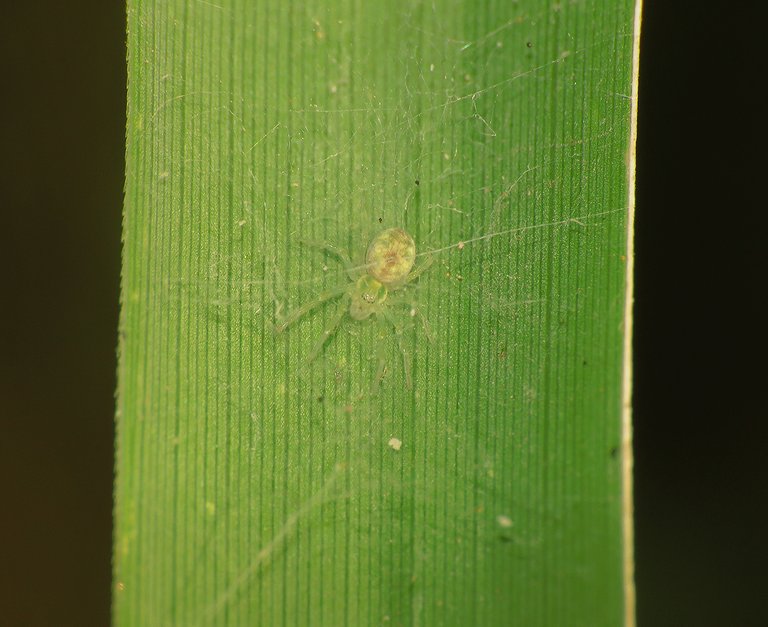
Here you can see another nice example of mimicry. The tiny spider is well hidden in plain sight on the upper surface of the leaf. It looks like a tiny pale dot.
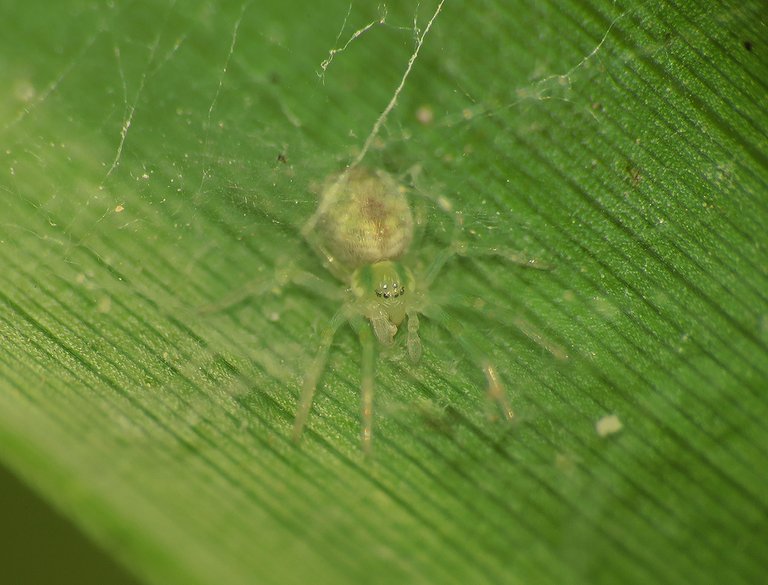
The name of the species is Nigma puella. The family is Dictynidae. Like in many other spiders, the abdominal markings can vary from individual to individual in this species. This Nigma puella has a pale pinkish shape in the center of the upper surface of the abdomen. In the following photograph ...
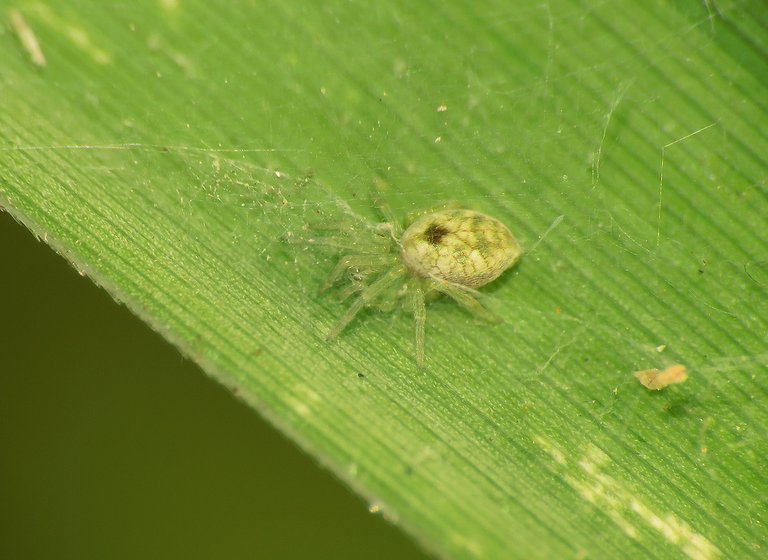
... you can see one decorated with a dark spot.
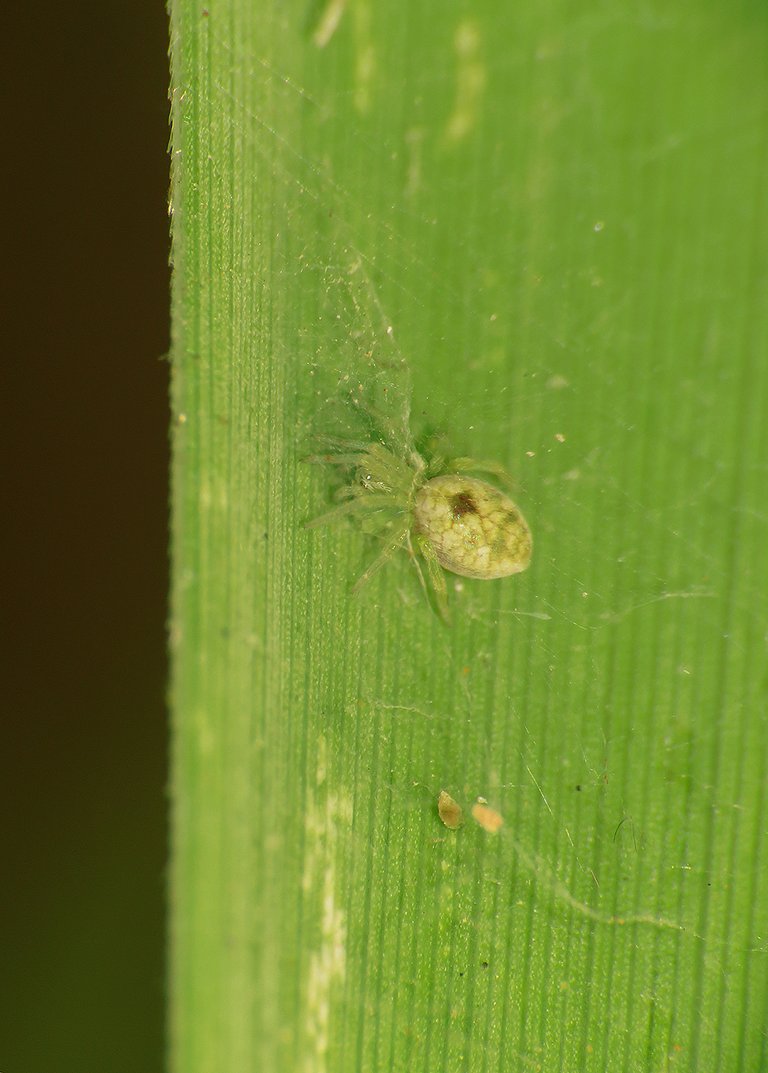
Here you can see a slightly different, vertical version of the same thing.
The Nigma puella shown in this and the following photograph ...
... has a series of green markings.
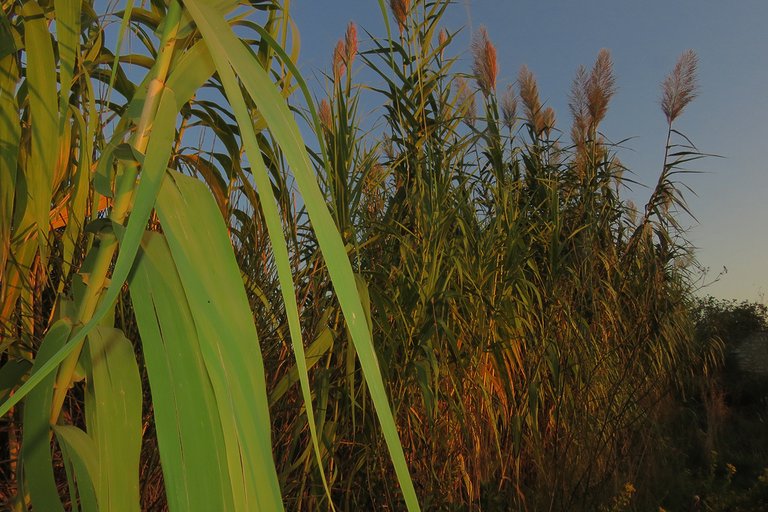
Here you can take another beneficial break from the macro view by watching the reeds for at least three seconds. The photograph was taken in the evening.
This fly from the Tephritidae family was the highlight of the macro experience on October, the third for me. Despite being a very common species whose larvae feed on olives, I somehow never saw or photographed it. Maybe the battle against this pest on precious olive trees has been successful so there aren't many olive fruit flies (Bactrocera oleae) around in this area. The adult flies feed mainly on honeydew produced by scale insects. When it comes to the visual appeal of an adult Bactrocera oleae, I think that this is a beautiful insect with trippy eyes.

This pretty big, bee-mimicking fly from the Syrphidae family ...
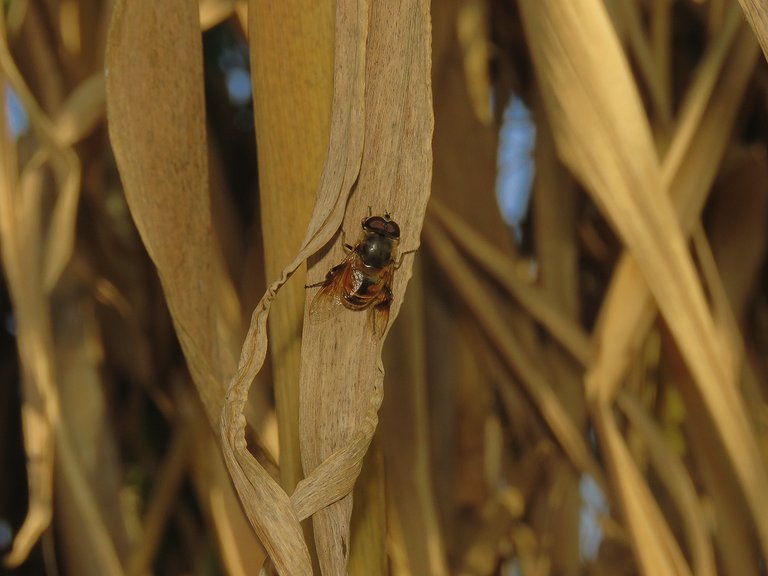
... was resting on the dry foliage in the lower part of the reed. The name of the species is Eristalis tenax.
I found quite a few interesting flies that afternoon. These two very small ones were mating on the grass that grows under the reeds. In this case, I can't tell you the name of the species but I'm completely positive that the family is Phoridae and I'm almost sure that the genus is Megaselia.
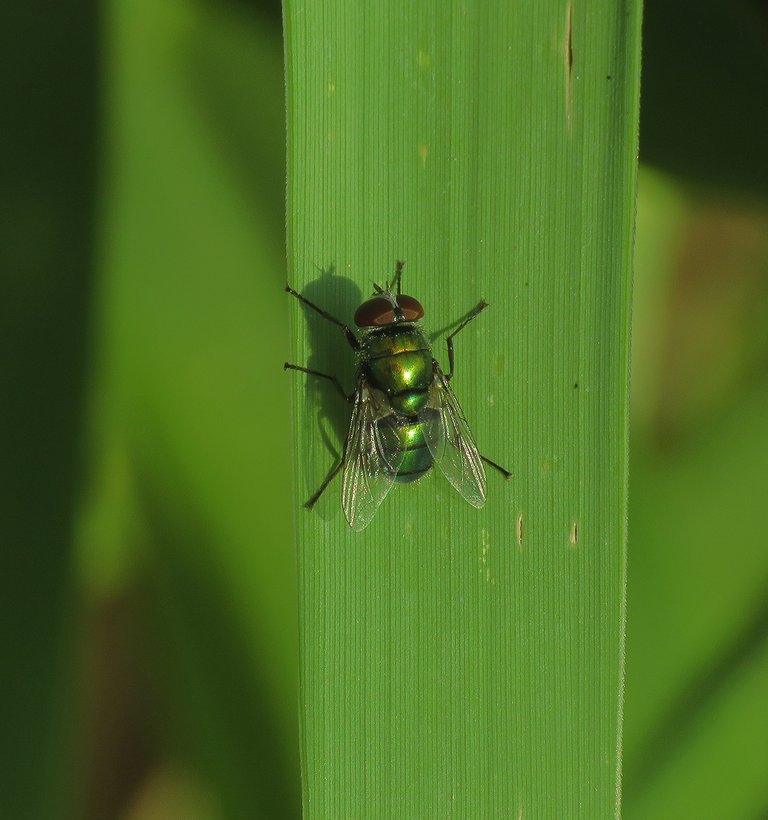
This Chrysomya albiceps, a species from the Calliphoridae family was resting on one of the leaves closer to the top than to the base of the reed. I had to stand on the tips of my toes to get the shot.
This pretty big gray fly belongs to the Sarcophagidae family. The name of the species is Sarcophaga carnaria. That's the last one, I have no more flies to show today. Before continuing with other insects ...
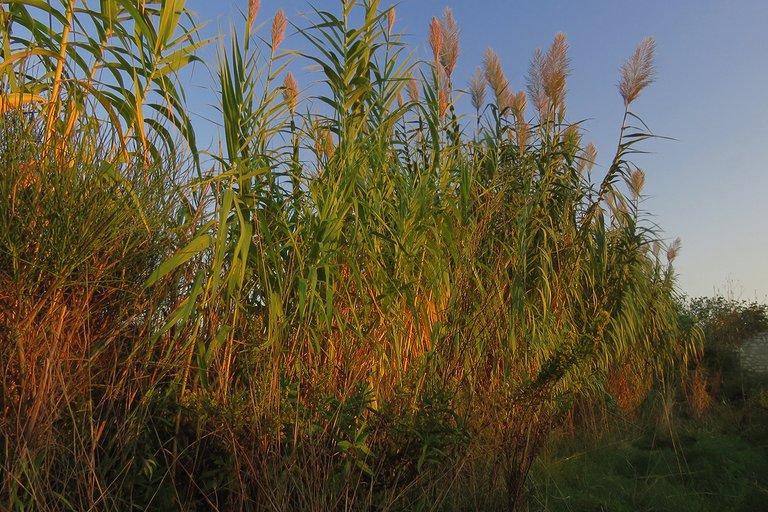
... I suggest another quick break from the macro view.
When it comes to this wasp from the Ichneumonidae family, I'm pretty sure that the genus is Lissonota, but I can't tell you anything more precise than that.
This is a small juvenile Runcinia grammica, a spider from the Thomisidae family that appeared in the previous episode as well. The leaves of the reed provide a very nice, kinda simple but stylish background that looks great in portraits of insects and spiders.
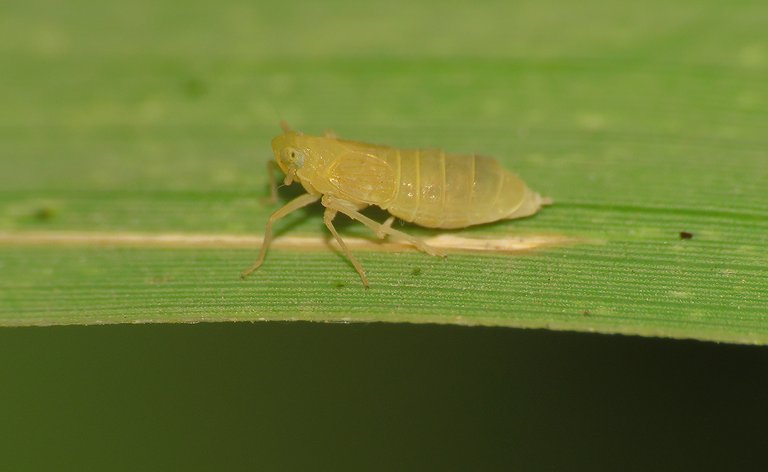
I can't tell you much about the planthopper shown in this and the following photograph. It belongs to the Delphacidae family, that much I'm sure of. It looks a lot like a nymph, but is more likely that it's an adult female, in my opinion. It looks like the insect has just gone through molting - is still pale and soft. Struebingianella lugubrina is one of the species I found on the Internet that has some similarities with this planthopper, but that doesn't mean much. If you know the name of the species, I'll gladly hear it from you.
Here you can take a look at the other side of the same insect. I don't know what are those two dark spherical things in the abdomen. Never saw anything like that on a planthopper and a pretty long Internet search hasn't provided me with any answer. In the following set of four photographs ...
... you can see a bug that I wasn't able to identify. I mean, I'm sure that the insect belongs to the Miridae family but with quite a few similar species around, I can't tell you which one exactly is this.
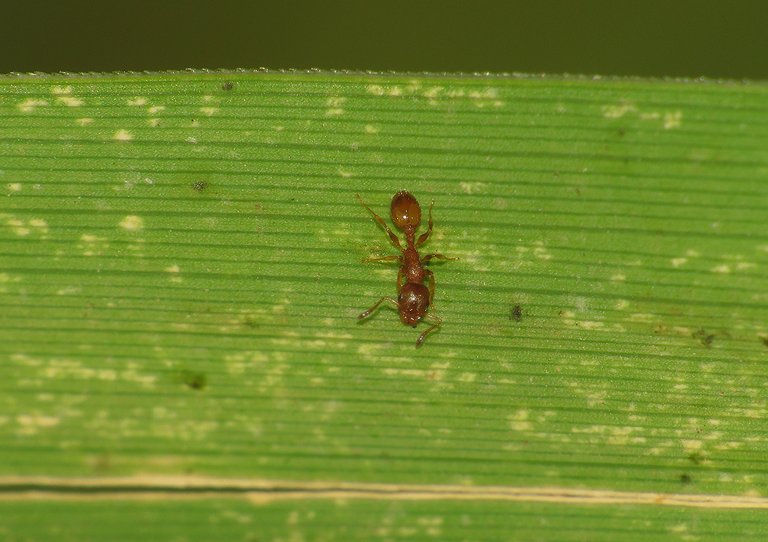
This tiny ant, probably a Temnothorax affinis worker, was photographed on one of the leaves on the lower part of the reed.
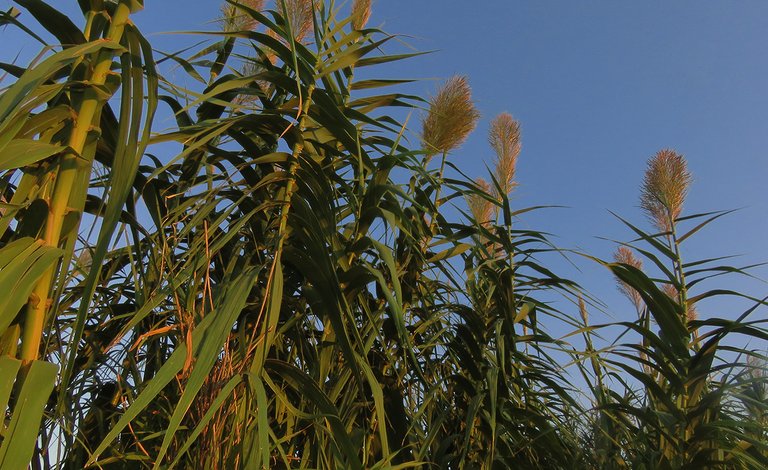
AND THAT'S IT. HOPE YOU ENJOYED EXPLORING THE REEDS WITH ME IN THIS EPISODE. AS ALWAYS HERE ON HIVE, THE PHOTOGRAPHS ARE MY WORK.
The following links will take you to the sites with more information about the protagonists of this post. I found some stuff about them there.
https://en.wikipedia.org/wiki/Angle_shades
https://en.wikipedia.org/wiki/Nigma_puella
https://en.wikipedia.org/wiki/Olive_fruit_fly
https://en.wikipedia.org/wiki/Eristalis_tenax
https://en.wikipedia.org/wiki/Phoridae
https://en.wikipedia.org/wiki/Chrysomya_albiceps
https://en.wikipedia.org/wiki/Lissonota
https://en.wikipedia.org/wiki/Runcinia_grammica
https://www.britishbugs.org.uk/homoptera/Delphacidae/Struebingianella_lugubrina.html
https://en.wikipedia.org/wiki/Temnothorax_affinis
https://en.wikipedia.org/wiki/Phragmites_australis

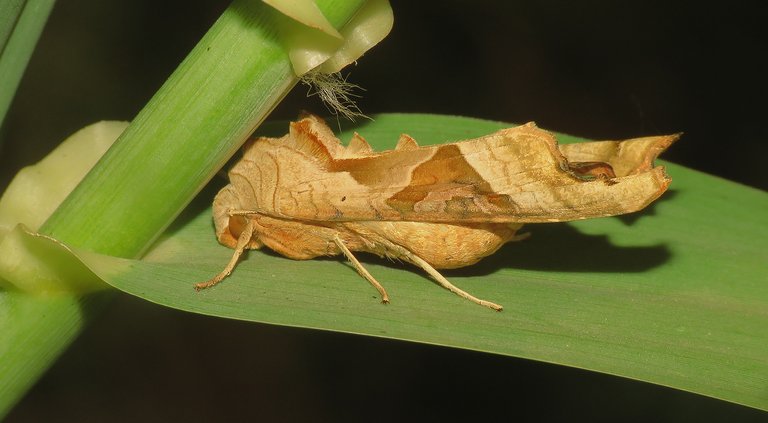
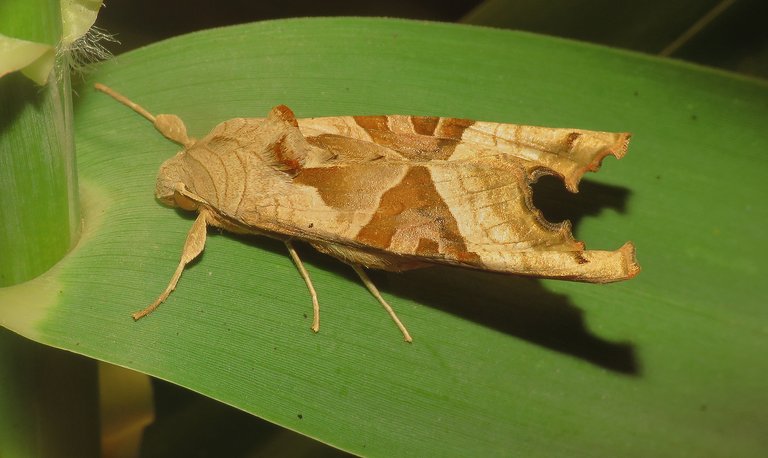
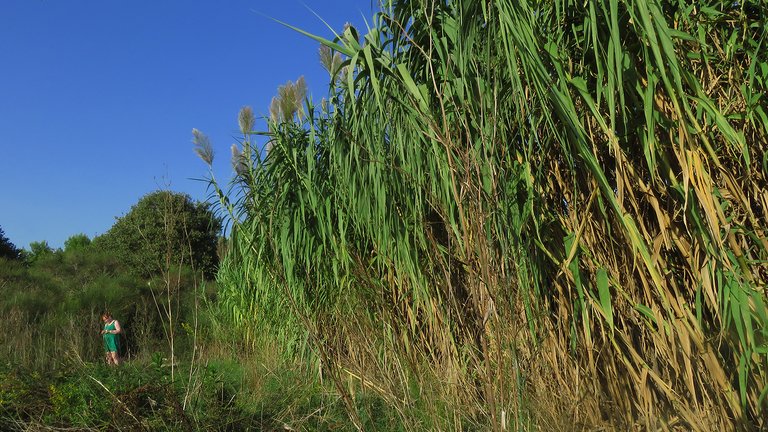



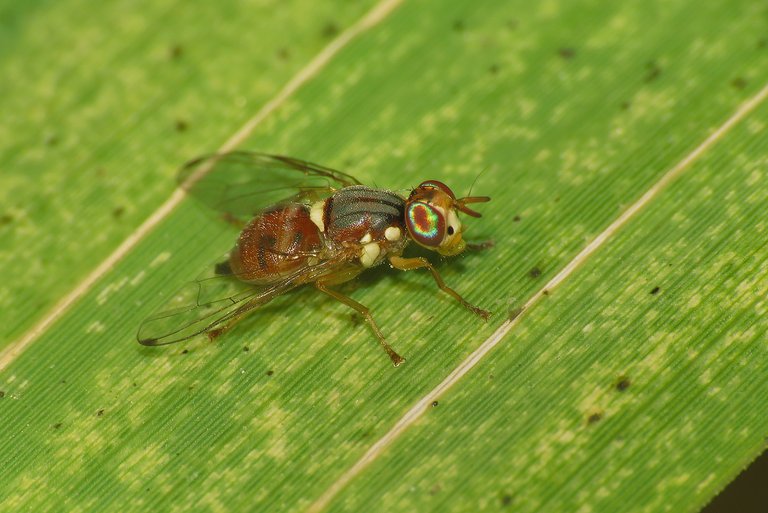
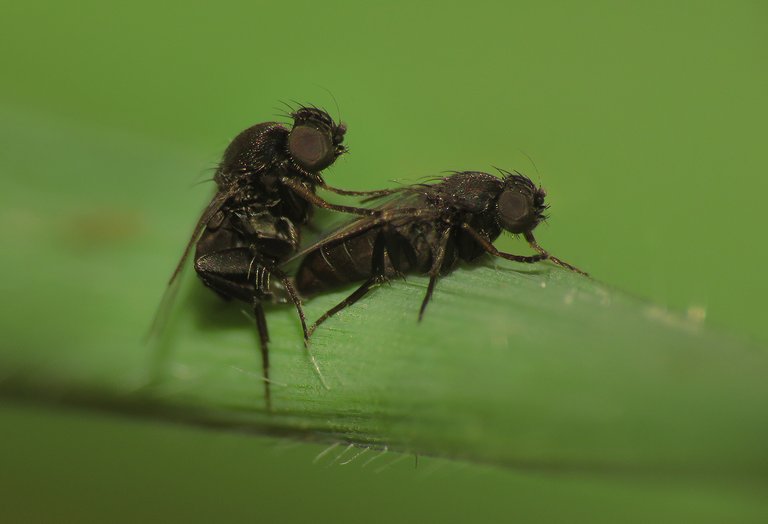
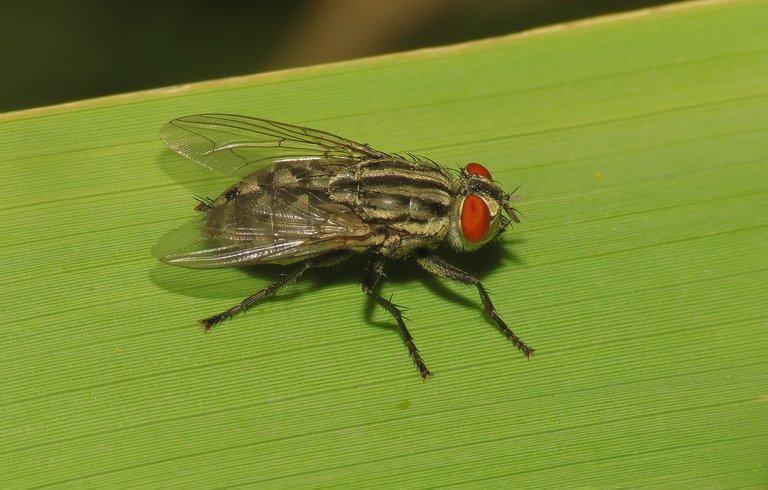
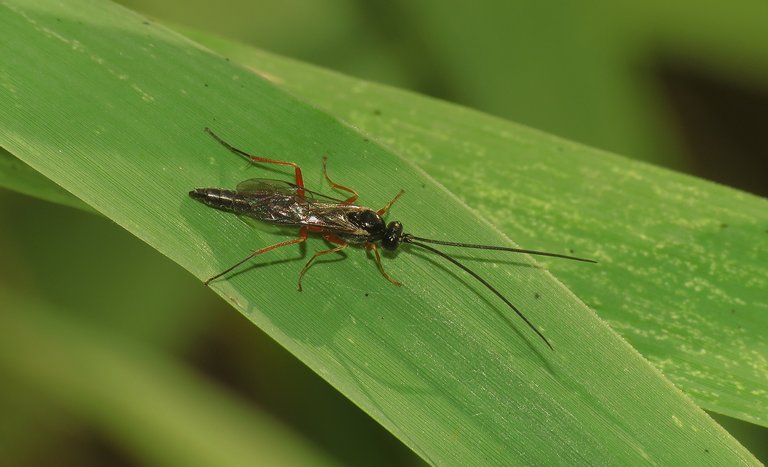
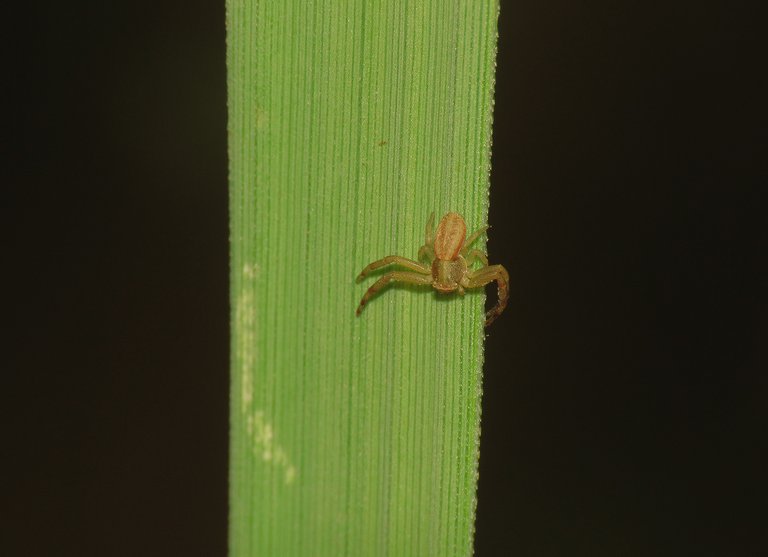
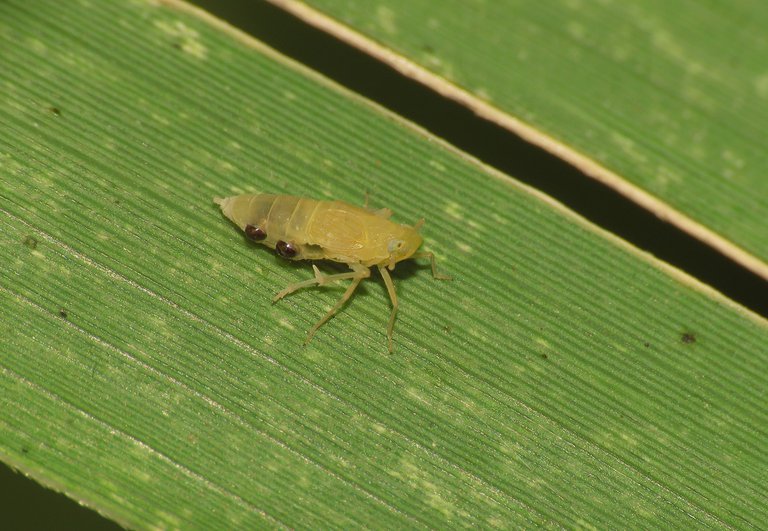
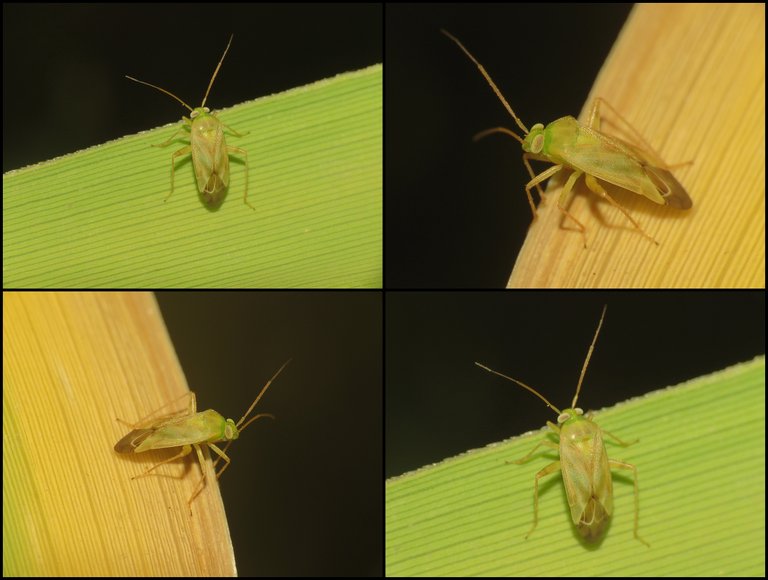
The photo of the insect that you took is really very beautiful and beautiful and it is really unique
Marlera is a very beautiful place for macro shots. Shots you have taken are worth-seeing.
The spider is really camouflaged!
Wonderful early autumn scenes, colors, and insect gems!
The nature here is at its best in early autumn. 🙂 Glad you like the post.
I personally think the weather is best everywhere in early autumn ... your region of the world is providing POWERFUL evidence!
That's great, you are always mentioning the name of these species that enhanced the knowledge. Really the nature is so beautiful and full of such a pretty unique creatures.
Once it's nature, it's practically impossible not to get enraptured by all that beauty. Really sublime stuff, I must say and the intricacies and detailing in each of them is just wonderful.
Phlogophora meticulosa is a wonderful moth. I don't think I've ever seen such a beautiful moth. It looks really amazing and looks a lot like a dry leaf.
Yes. Moths that mimic dry leaves are often very beautiful and interesting. This species is one of the most interesting here where I live.
The insect world really is like one big world on its own right!!! We tend to look past that everyday of our lives...
I do fancy that almost transparent spider... Somewhat freaky since I am not the biggest fan of spiders but hey
😃 Yes, spiders are a bit of an acquired taste. There is something in their shape ... I don't know ... it took me many years of observing them to get comfortable with them. Now I'm OK with spiders crawling on me, but a few decades ago I wouldn't let that happen no chance.
That moths colouring is really cool ..so stealth like! I dig moths.
That little spider looks transparent! ..remarkable. First time I've ever seen that! Thanks mate for enlightening me. Really dig how the abdomen is like a milky dot. I don't really know how it all works, but is that spider silk in there somehow? Like a supply ready to be spun? Or am I just dreaming up nonsense and making no sense at all lmao?
Was blown away by the colouring of the eye on that fly. Kinda reminds me of an opal - that's so wild.
Such awesome pics my friend. Right down to the ant in the end! I reckon you're so talented with photography.
Looks like we have many Spiders Today, and a pair of flies "getting it on" !LOL
Life is always busy in the "Natural World" commanded by Mother Nature of course!
Have a great day Borjan, and thanks for sharing your epic photos again ... Stay !ALIVE
!VSC 👌
@fun.farms has sent VSC to @borjan
This post was rewarded with 0.1 VSC to support your work.
Join our photography communityVisual Shots
Check here to view or trade VSC Tokens
Be part of our Curation Trail
@fun.farms ha enviado VSC a @borjan
Éste post fue recompensado con 0.1 VSC para apoyar tu trabajo.
Únete a nuestra comunidad de fotografía Visual Shots
Consulte aquí para ver o intercambiar VSC Tokens
Se parte de nuestro Trail de Curación
@borjan! You Are Alive so I just staked 0.1 $ALIVE to your account on behalf of @ fun.farms. (1/10)
The tip has been paid for by the We Are Alive Tribe through the earnings on @alive.chat, feel free to swing by our daily chat any time you want, plus you can win Hive Power (2x 50 HP) and Alive Power (2x 500 AP) delegations (4 weeks), and Ecency Points (4x 50 EP), in our chat every day.

lolztoken.com
To the dock
Credit: reddit
@borjan, I sent you an $LOLZ on behalf of fun.farms
(1/10)
You have very sharp eyesight to find these little insects in the weeds dear friend @borjan
I love your insect posts, you always present us with unique and beautiful specimens like this moth, I have never seen one with that color combination
Beautiful photographs, you always pleasantly surprise us.
Have a great day
My eyesight works well - but only when I have the glasses on. 😃 Have a great day. Glad you love nature and like this post.
First time of hearing that insect name before and it turns out to be really amazing
🙂
It's so beautiful to view. The Insects has a world on it and each time you visit it, you are always bringing value and loads of them. Weldone 🙌
Awww! Always taking my breath away with this colourful writeups☺️ you are welcome
🙂
https://twitter.com/LovingGirlHive/status/1712465410577383494
Your macro shots are very nice
They look so beautiful
Nice one!
I was very impressed by this photo;
...so many beings around us, living and reproducing, you just have to look closely to see these beauties. Beautiful !
Yes, life on this planet is absolutely fantastic. It comes in so many shapes and colors. 🙂 Glad you like the post.
Greetings From Havana!!!!🙏
You are macro shorts are awesome
I never see that type of moth before...
All pictures are beautiful :-)
Wow, what a wonderful micro photography.
Want to Know more about Hivepakistan?
Ping Us On Hive Pakistan Discord server
To support HivePakistan, delegate Hive Power to hivepakistan and earn 90% curation reward :)
Here are some handy links for delegation
A delegation of 500 or more HP makes you earn Hivepakistan supporter badge.
You're welcome
Always like to see your posts because and increase my knowledge about insect's.
Most welcome dear.
!ALIVE | !PGM | !LOLZ
@borjan! You Are Alive so I just staked 0.1 $ALIVE to your account on behalf of @ vocup. (3/20)
The tip has been paid for by the We Are Alive Tribe through the earnings on @alive.chat, feel free to swing by our daily chat any time you want, plus you can win Hive Power (2x 50 HP) and Alive Power (2x 500 AP) delegations (4 weeks), and Ecency Points (4x 50 EP), in our chat every day.

BUY AND STAKE THE PGM TO SEND A LOT OF TOKENS!
The tokens that the command sends are: 0.1 PGM-0.1 LVL-0.1 THGAMING-0.05 DEC-15 SBT-1 STARBITS-[0.00000001 BTC (SWAP.BTC) only if you have 2500 PGM in stake or more ]
5000 PGM IN STAKE = 2x rewards!
Discord
Support the curation account @ pgm-curator with a delegation 10 HP - 50 HP - 100 HP - 500 HP - 1000 HP
Get potential votes from @ pgm-curator by paying in PGM, here is a guide
I'm a bot, if you want a hand ask @ zottone444
lolztoken.com
Earthquacks
Credit: reddit
@borjan, I sent you an $LOLZ on behalf of vocup
(1/10)
Delegate Hive Tokens to Farm $LOLZ and earn 110% Rewards. Learn more.
Nice photos, mate them in peace bro🤣Haha
😀
The Phlogophora meticulosa moth is so interesting to study, the odd shape, the patterns, the colors. The plant hopper with the dark spots, those spots could be a parasite.
Yes, a parasite sounds like the most plausible explanation.